COASTLINES
By Janice Allen Deputy Director, Coastal Land Trust


There is nothing more aweinspiring than big trees. Their stature and girth command respect; their immensity and age capture our imagination. The Coastal Land Trust certainly has protected some large and wondrous trees over our 24 year land conservation career, including a state champion red bay at our Sea Gate Woods Preserve in Carteret County (for more on state champion trees, read Todd Pusser’s “The Last Giants, Searching for Champion Trees in North Carolina,” March–April 2016, Wildlife in North Carolina, magazine). While these single tree records are incredible, it is even more fun to conserve a forest of giants. This past January we did just that with the purchase of additional land along the Meherrin River in Northampton County from Conservation Forestry, LLC. The Coastal Land Trust’s new 526-acre nature preserve hosts an amazing old growth floodplain forest, one that we could easily dub our “Big Tree Preserve.”

We always knew this out of the way place along the Meherrin River
was special. Mike Schafale of the North Carolina Natural Heritage Program pointed it out to us several years ago, highlighting its relatively pristine condition and extensive population of Douglass’ bittercress, a rare plant (numbering there in the thousands). But it is the big trees on the property that really stood out to us. On a recent site visit, Lee Leidy, our Northeast Region Director, exclaimed, “There are some monster trees in there!” Yes, monsters on the Meherrin. Most of the forest is quite mature, with trees averaging 16 inches diameter at breast height (dbh) but with many trees reaching 20 to 30 inches dbh! Canopy trees include bald cypress, willow oak, cherrybark oak, swamp chestnut oak, water tupelo, laurel oak, willow oak, shagbark hickory, tulip poplar, and green ash. Perhaps no state records exist, but the quality, quantity, and diversity of big trees are exceptional.

These big trees provide copious food in the form of acorns and seeds, and shelter (cavities and knotholes) for all sorts of wildlife—ducks, bats, woodpeckers, squirrels. Some of the

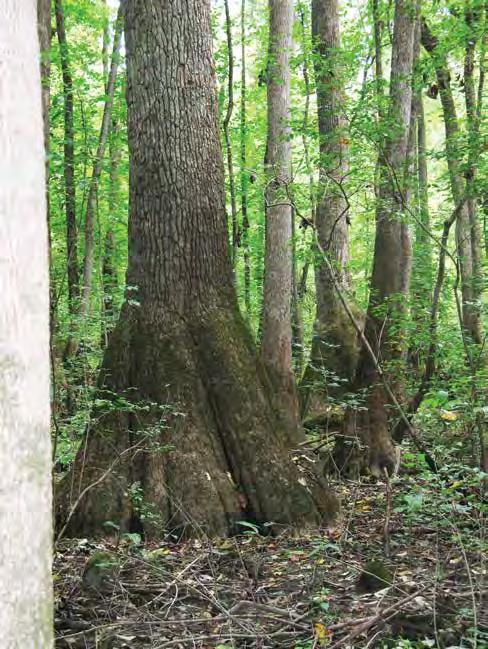

One of the best parts of travelling the coastal plain of North Carolina, aside from seeing the natural beauty of the land, is seeing all the historical highway markers.
Learning bits of history helps anyone, from Native North Carolinian to tourist, develop an understanding of how we all were influenced by the actions of our ancestors. As any cautious driver learns, it is nearly impossible to read all of the descriptions on the signs while safely steering the vehicle in the lane. Finding out the rich history of North Carolina is a fascinating adventure, and fortunately for the Coastal Land Trust, a notable path of the Civil War crossed right through one of its preserves – no highway signs necessary.
The Gales Creek Preserve at Camp Sam Hatcher is located in Carteret County near the Croatan Forest in Newport. A walk through the property and a familiarity with surrounding geography explains exactly why the land was pivotal in the Civil War. The Preserve has access to the Bogue Sound through a series of creeks, making it an ideal place to receive supplies.
A.
B.
C.
MAIN OffICE
131 racine Drive, Suite 202 Wilmington, nC 28403 (910) 790-4524 (910) 790-0392 Fax


Camilla M. Herlevich executive Director ext. 206 camilla@CoastalLandTrust.org
John Napiecek Business Manager ext. 204 john@CoastalLandTrust.org
Jim Coyle Controller jim@CoastalLandTrust.org
Mary Ellen Slugg Legal and Administrative Assistant ext. 208 maryellen@CoastalLandTrust.org
Jesica C. Blake Director of Stewardship and Community Conservation ext. 203 jesica@CoastalLandTrust.org
Christopher Ketchie Stewardship Biologist ext. 207 chris@CoastalLandTrust.org


Tatum Justice Stewardship Assistant ext. 201 tatum@CoastalLandTrust.org
Matthew Lide Americorps Service Worker americorps@CoastalLandTrust.org
Vann Pearsall Director of Development ext. 210 vann@CoastalLandTrust.org

Beth W. Steelman Development Associate ext. 200 bsteelman@CoastalLandTrust.org
Stephanie Borrett Development Assistant ext. 209 stephanie@CoastalLandTrust.org

Janice L. Allen Deputy Director 3301-G Trent road new Bern, nC 28562 (252) 634-1927 janice@CoastalLandTrust.org
NOrTHEAST OffICE
Lee L. Leidy northeast region Director Attorney at Law 205 n. Water Street, Suite 1 elizabeth City, nC 27909 (252) 335-9495 lee@CoastalLandTrust.org www.CoastalLandTrust.org
Linda Murchison has recently retired as a social worker at Lower Cape Fear hospice and previously served as a Chaplain Associate at new hanover regional Medical Center, but continues her community service as an energetic volunteer leader in a wide variety of nonprofits. She serves in lay leadership positions at her church in Wilmington. She and her husband have led and contributed to a host of fundraising campaigns benefitting causes in Wilmington and in Wyoming.
Linda served two three-year terms on the Coastal Land Trust Board previously, including two years as President.

Kris Pickler serves as Senior Counsel, international real es tate to Lowe’s Companies, inc. in Charlotte. Previously, he has worked in private practice in raleigh and Charleston law firms, and also held several environmental positions, including a stint as

Marine Policy Fellow for the US Senate, and as environmental planner for the state of South Carolina.
he has both a law degree and a masters in coastal environmental management. Kris has been an active member of the Coastal Land Trust’s Land Committee for two years, and also volunteers for The nature Conservancy. he and his wife, who hails from new Zealand, live in Davidson, nC , and travel back to new Zealand when they can.
Will Purvis is Chief Development Officer for the Liberty healthcare companies, a familyowned and operated business, whose portfolio includes nursing facilities, senior care communities, and homecare/hospice offices primarily in north Carolina. Will has previously been a banker with BB&T.
A native of northeastern nor th Carolina, he and his wife currently live in Wilmington, and vacation on Ocracoke. his business undergrad and graduate degrees are from nor th Carolina State University and Wake Forest University respectively. Will volunteers with the Boy Scouts, the Wilmington Chamber of Commerce, and new hanover
regional Medical Center Foundation.
John Fussell, who will be serving his second threeyear term on the Board, is an environmental consultant, naturalist and author. he has completed many bird and plant surveys for various federal and state agencies and other clients, and has provided pro bono assessments to the Coastal Land Trust. John served two three-year terms on the Board of Directors of the Coastal Land Trust previously. he has both a bachelor’s degree and a master’s degree from nor th Carolina State University.
Lovay Wallace-Singleton, who filled an unexpired term on the Board in 2015, will be serving her initial three-year term. She is the founder and Program Director of veterans employment Base Camp and Organic Garden. This non-profit is dedicated to assisting homeless veterans with transitional employment and disabled veterans with horticultural therapy using an organic garden at henderson Park in new Bern. Previously, she served 20 years in the U. S. navy as an Air Traffic Control Supervisors, and as a Federal Budget technician. her degree is in Business Administration.
note: the construction is two hexagonal fortresses built on top of each other so as to provide 360 degrees of view.
The tract is north of what is now Highway 24, and back in the times when it was too complicated to construct bridges over waterways, roads were built in places that would not be destroyed by a swift current.

There is believed to have been a Union blockhouse in the center of the property that is now the Gales Creek Preserve. The position of the blockhouse was along the old road. The creators would have cleared the patch of the forest in a radius of 200 yards, and the pines that were cleared made for abundant building materials. The purpose of the blockhouse was to act as a warning post positioned miles in front of the Newport garrison. In the event of an enemy invasion, a soldier would be dispatched to go warn the next company down the road.
A skirmish at Gales Creek Blockhouse on February 2, 1864 was the opening engagement of a Confederate attempt to retake New Bern, NC, by neutralizing Union forces in Carteret County. Robert E. Lee detached troops from his army in Virginia for the second winter season to assault New Bern. His first attempt was during the previous winter of 1862-63, led by General D.H. Hill, but it was not a successful endeavor.
General George Pickett of Gettysburg commanded the new effort. Pickett enlisted the help of General James G. Martin’s brigade of North Carolinian Troops from Wilmington. The plan was to assault the Newport Barracks in order to cut off the New Bern garrison from supplies received via the railroad that ran from Beaufort and Morehead City. Martin’s Confederate forces advanced, and in several days, they were in position to attack. The 17th and 42nd NC Infantry, along with the North and South Carolina Cavalry and artillery, took Gales Creek Blockhouse en route to the Newport Barracks. After a twohour lively running fight in the surrounding pine forest and wetlands, 85 Union soldiers from the 9th Vermont Infantry and the 23rd New York Cavalry were ousted from the area.
The Bogue Sound Blockhouse and Newport barracks were captured by nightfall as Martin’s troops progressed. However, Martin’s great effort was negated by the dismal failure of Pickett’s forces outside of New Bern. Pickett had ordered General Seth Barton to assist with taking New Bern, but a miscommunication and fluke in the plan exposed the Confederate forces and rendered the capturing of the Newport Barracks useless.

At the end of the day of February 2nd, 1864, the Confederate army lost six soldiers and fourteen were wounded. The Union losses were three men killed, thirteen wounded, and forty eight captured. Of those, twenty nine of the captured men perished later in prison camps. Overall, 3,500 men took place in the Battle of the Newport Barracks. This was the largest and bloodiest battle to occur in Carteret County. For those previously unfamiliar with this piece of history, a highway marker in Newport acknowledges the Battle of the Newport Barracks. Even though this battle is not in every history textbook and does not have as much notoriety as those that took place in Gettysburg or Antietam, it does not make the impact any less significant. The lives of those lost and those who had to witness the war should be remembered throughout the generations – and sometimes a post on the side of highway does not quite do it justice.

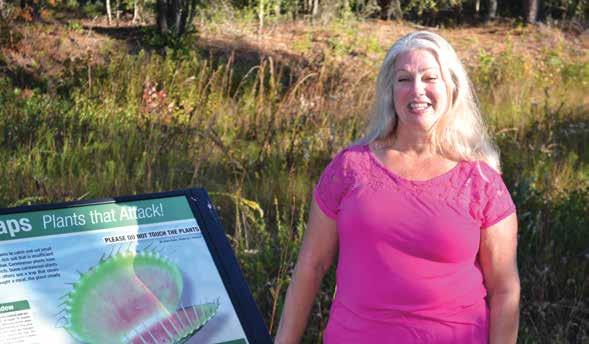 By Ashley Gordon Coastal Land Trust Spring Intern
By Ashley Gordon Coastal Land Trust Spring Intern

Development. Deforestation. Pollution. These are words that typically come to mind when thinking about the main reasons for habitat loss. Another phrase has entered the picture: climate change. Speculations of climate change impacts buzz throughout the media, such as longer droughts in some regions and more intense hurricanes in others.

Since the Coastal Land Trust works in areas that may be at increased risk from sea level rise, we are implementing a strategy to incorporate the impacts of climate change in our conservation planning. To aid with these efforts, the Coastal Land Trust received $22,000 from the Conservation Trust for North Carolina (CTNC) in partnership with the Open Space Institute with support from Z. Smith Reynolds Foundation. Through its grant program, Conservation Planning to Ensure Resilient Landscapes in NC, CTNC is working to build the capacity of land trusts
in North Carolina to respond to climate change by integrating resilience data into conservation planning. These funds will assist the Coastal Land Trust in updating watershed conservation plans with climate resilience data.
So what is climate resilience? “Resilience” has been defined as the ability of a site to adapt to climate change while continuing to support diverse wildlife. A variety of landforms, such as mountains or valleys, and connected patches of natural areas, such as forests or wetlands, are likely to increase a site’s resilience because these features provide wildlife with new suitable habitat.
To incorporate climate science into conservation work, The Nature Conservancy has developed a model that ranks the climate resilience of land along the eastern United States. The Coastal Land Trust plans to use resilience scores from this model to guide its land acquisition and conservation strategy and create a network of climate resilient sites that protect the places we love along the coast.































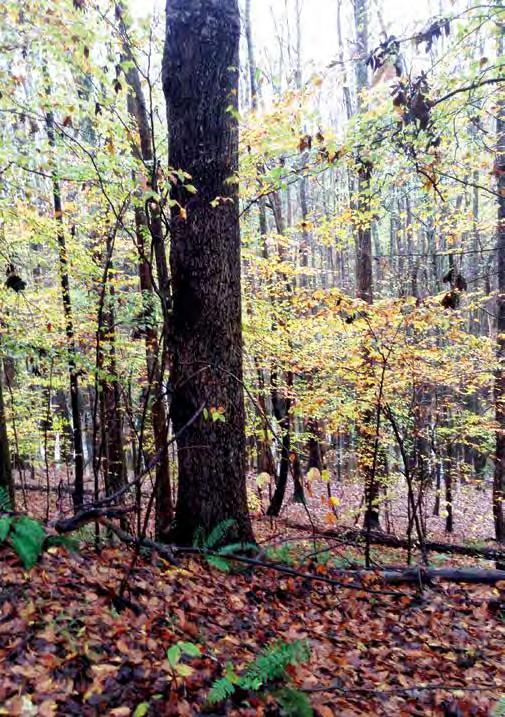


The Coastal Land Trust has saved another 90 acres of truly stunning hardwood forest along Dam Creek, a tributary of the Neuse River in Craven County. Six plus acres located at the mouth of Dam Creek, where it empties into the Neuse River, were purchased on August 8th, 2016. Four days later, the Coastal Land Trust acquired 84-acres featuring an absolutely gorgeous hardwood forest on the opposite end of Dam Creek, at its headwaters. With these back to back purchases, the Coastal Land Trust has expanded its existing Dam Creek Nature Preserve from 38 acres to more than 120 acres conserving frontage along nearly the whole Dam Creek!

“The Coastal Land Trust has slowly and strategically conserved parcels of land along Dam Creek that connect and provide tremendous habitat for wildlife including colorful songbirds like the Prothonotary Warbler, elusive mammals like flying squirrels, and even rare butterflies like the Duke’s skipper butterfly. These new properties are a tremendous addition to the Coastal Land Trust’s Dam Creek Preserve, a nature preserve which not only provides green space near the Carolina Pines and Royal Oaks Subdivisions, but is deemed of conservation importance to the nearby Marine Corps Air Station Cherry Point which contributed significant funding. The entire Dam Creek Preserve is a small but significant ecological gem, which hosts rich hardwood forest on rolling topography, an unusual feature for the coast,” said Janice Allen, Deputy Director of the Coastal Land Trust.
The Coastal Land Trust secured grants and funds from several different sources to purchase these properties: the NC Clean Water Management Trust Fund; the U.S. Fish and Wildlife Service’s North American Wetlands Conservation Act program, the Fred and Alice Stanback Fund, and the US military’s Readiness and Environmental Protection Integration program. Additionally,
contributions to the Coastal Land Trust’s stewardship endowment were provided by The Conservation Trust for North Carolina and Mr. and Mrs. Eddie Ellis.
“The Coastal Land Trust is grateful to our military partner—MCAS Cherry Point, and to our many funders” said Ms. Allen, “for their investment in this small but special place in Craven County.”
continued from page 1
large oaks even extend above the plane of the canopy and are called “super-emergent” or “super-canopy” trees. These super-canopy trees are of high importance in bottomland forests and provide nesting sites for bald eagles and other raptors, and serve as rookeries for colonial waterbirds like great blue herons. These super-canopy trees with their sprawling crowns are also bug magnets providing microhabitats for a diversity of insects that subsequently attract a diversity of songbirds to eat them, especially during migration. They are like fast
food stations for our songbirds! We all have heard about the multiple benefits of big trees from being nature’s air-conditioning to carbon storage units, regulating temperature and cleaning our air. For many of us, big trees stir our souls and are important simply because they are there.
Thanks to funds from the U.S. Fish and Wildlife Service and Coastal Land Trust’s conservation efforts, these monsters of the Meherrin will continue to age, grow and spread their limbs for many more years to come.
Coastal Land Trust thanks Kent Gilges of Conservation Forestry for partnering with us to permanently protect 500 acres of land along the Meherrin River. Conservation Forestry is a timber investment company founded in 2004 with the strategy of seeking to align private equity with conservation capital for the purpose of acquiring and managing large, forest landscapes. The company seeks to achieve a competitive risk adjusted rate of return for their investors while enhancing the conservation values of the forests they manage. Conservation Forestry currently manages approximately 700,000 acres of timberlands across the United States, and through the implementation of their strategy has facilitated the permanent protection of over 300,000 acres of forestland. In Virginia and North Carolina alone, their investments have facilitated the permanent protection of 10,700 acres.





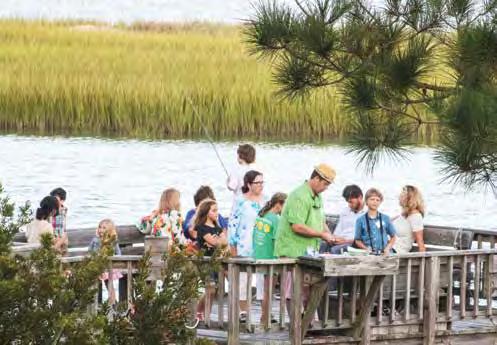



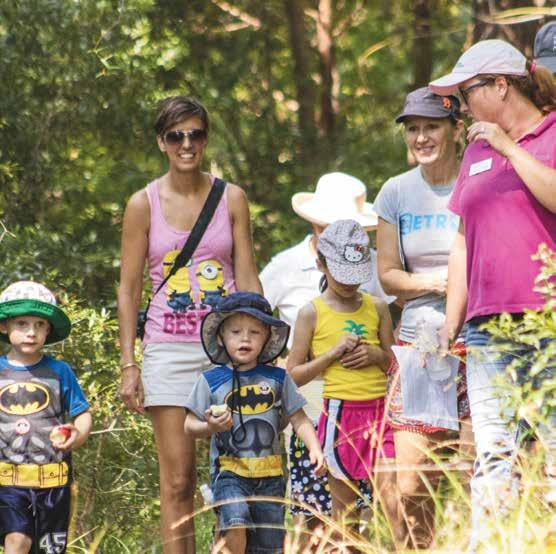
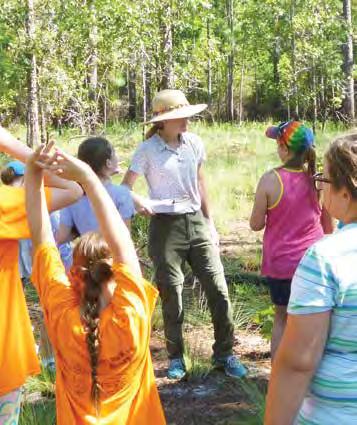


big-eared bats.
salamanders, and Rafinesque’s
Mississippi kites, anhinga, dwarf
interesting wildlife like
along with habitat for other
ducks and hooded mergansers
of waterfowl including wood

this property host an abundance
extensive floodplain wetlands on
Plantation Game Lands. The
part of the 1,600+acre Whitehall
Commission to be managed as

North Carolina Wildlife Resources
2016 and transferred it to the
Bladen County on August 25,
along the Cape Fear River in
approximately 174 acres of land

The Coastal Land Trust purchased
CoastalLandTrust.org/donate
When Camilla asked the Coastal Land Trust’s summer interns about their favorite summer experience, the resounding response was “the trip to Springer’s Point.” And this wasn’t just a field trip, it was a work trip.
When the interns and staff members Tatum Justice and Stephanie Borrett met Lee Leidy (northeast region Director) ) at Springer’s Point, on Ocracoke island, the living shoreline along Old Slough was strewn with seemingly a million loose oyster shells. The living shoreline project involved the placement of primary and secondary sills parallel to the eroding shoreline. The sills were constructed of mesh bags filled with oyster shell.
Through the winter storms, the wave energy broke some of the bags causing the shells to litter the shoreline. inclement weather slowed down the initial progress in picking up the loose shell, but it also provided the perfect opportunity for the group to join a nCCAT (north Carolina Center for the Advancement of Teaching) seminar on the history of Ocracoke and get a bird’s eye view of the village from the tower at nCCAT’s Ocracoke campus.
The photo at right shows the living shoreline, how it has buffered wave energy, allowed the marsh to regenerate, and help stabilize the area behind the sills. The area between the sills and the shoreline were previously planted with native marsh grasses, which we are thrilled to report are thriving! The loose shells have now been moved to a
Above: Duke Stanback Summer Intern Caroline Kealoha’s smile says it all! She’s holding a very wee crab in the palm of her hand.

Right: Coastal Land Trust interns work the living shoreline at Springer’s Point.
location above the marsh to be used in later shore stabilization work. i t was not all work and no play. The group met ed, former Coastal Land Trust board member, and Susan novell at howard’s Pub for dinner and afterward joined the norvells at their home on Ocracoke.

Give the gift
that will last forever!
Donate today at